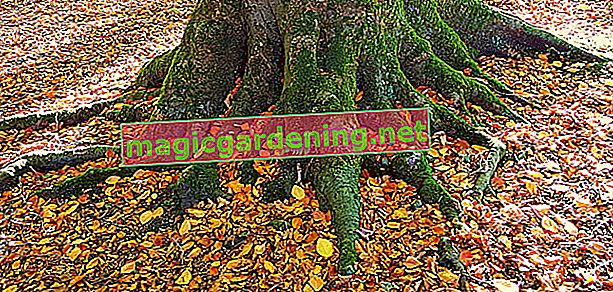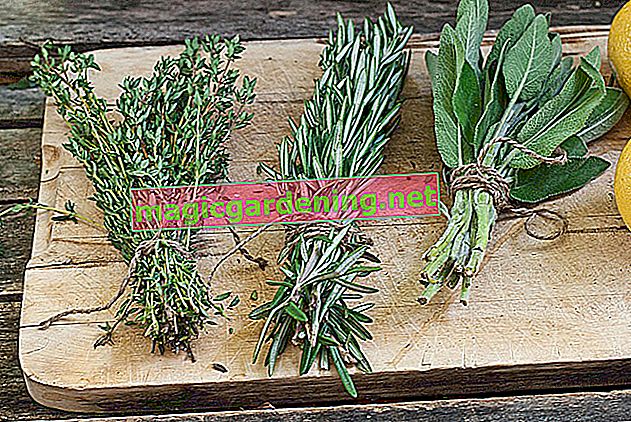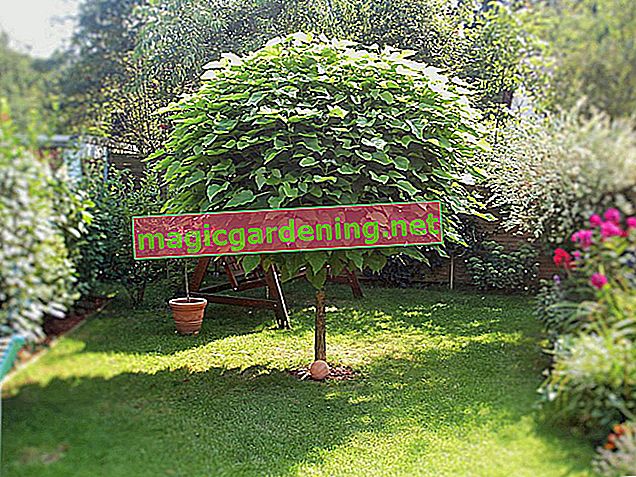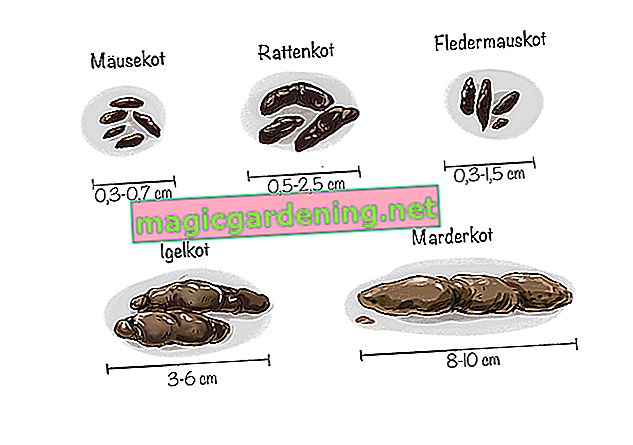
the essentials in brief
- Rat droppings are 1-2 cm long, dark brown and have a tapering spindle shape, comparable to large grains of rice.
- More than 120 dangerous diseases are transmitted through rat feces, such as hantavirus infection, cholera, dysentery, toxoplasmosis and salmonella.
- Removing rat droppings thoroughly and safely requires disposable gloves, a respirator and the use of effective disinfectants.
Recognize and distinguish rat droppings
What does rat droppings look like? That is the first question when finding excrement in the house and garden. Occasionally, a bad smell of ammonia aroused the worrying suspicion that rats were in the immediate vicinity. Of course, a hideous smell is not the sole criterion for the presence of the dreaded pests. The remains of some harmless small animals also give off a hideous smell. The following table gives an overview of the important properties of rat faeces compared to mice, hedgehogs and martens:
also read
- Recognize and distinguish hedgehog droppings - this is how it works
- Clearly recognize woodruff in the forest and collect it safely
- Detecting and removing fox droppings - information on fox tapeworm
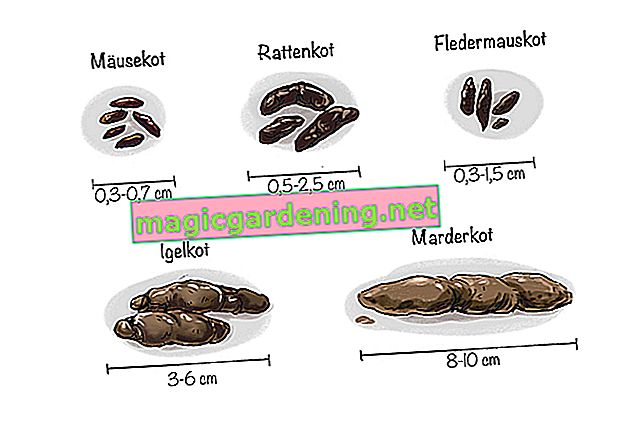
| comparison | Rat droppings | Mouse droppings | Hedgehog droppings | Marten droppings |
|---|---|---|---|---|
| size | 1-2 cm | 0.3-0.7 cm | 3-6 cm | 8-10 cm |
| Shape (appearance) | banana-shaped, tapering | spindle-shaped or round | rolled, pointed ends | twisted tip |
| colour | dark brown, shiny | dark brown | black to dark brown | black to dark gray |
| odor | for ammonia | strict | barely noticeable | hideous stench |
| Consistency (fresh) | sticky, soft | shiny, soft | firmly | coarse, visible food remains |
| Typical sites | + Basement | + Basement | + Bed | + Attic |
| + Attic | + Attic | + Garden paths | + Basement | |
| + along baseboards | + False ceiling | + Terrace | + Garden shed | |
| + Kitchen | + Kitchen | + paved areas | + Garden |
The rat excrement pictures below visualize the excrement in comparison with the excrement of mice, hedgehogs and martens. In the following we will go into more detail about the special properties. Practical tips provide information on the differences to the excrement of mice, hedgehogs and martens.
Mouse droppings or rat droppings?
The size, appearance and smell of the faeces in the table above serve as an initial indication of whether the polluters are mice or rats. To make matters worse for the layman, the legacies of young rats and adult mice can hardly be distinguished. Include the following additional aspects in the assessment in order to distinguish between mouse droppings and rat droppings:
- Mouse droppings : flat or randomly distributed in the house, mainly near the nest
- Rat droppings : concentrated at specific locations with up to 40 Kotkörnern per night
Mouse excrement occurs only sporadically at the beginning, mainly along walking paths and preferred resting places. In parallel to the explosion-like increase, the amount increases gradually. Adult house mice produce 60 to 80 excrement pills a day, which at 3-8 mm are significantly smaller than rat excrement. What at first glance looks like a bundle of fluff, on closer inspection often turns out to be mouse droppings. In contrast, the rat excrement latrines are hard to miss.
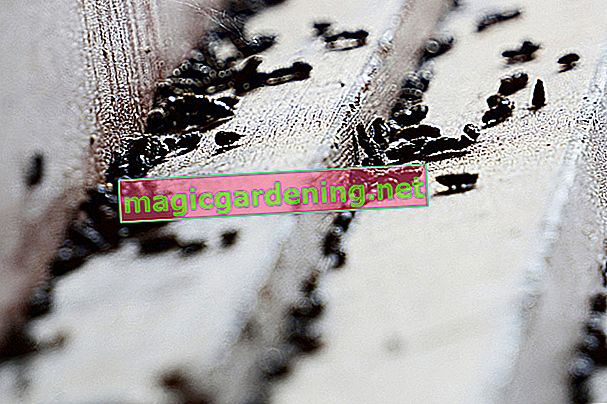
Hedgehog or rat droppings?
Joy and sorrow are closely related to the distinction between hedgehog droppings and rat droppings. Hedgehogs are very welcome beneficial insects in the garden, and as insect eaters they actively support the natural gardener in pest control. For hobby gardeners, rats in the garden pose a high risk of frightening the rodents away while working on the ground and of causing dangerous bite wounds.
You will be spared long guesswork if you want to differentiate the solutions of hedgehogs and rats. At 3 to 6 centimeters, hedgehog droppings are more than twice as long as rat droppings. To test, simply hold a match next to it to dispel any doubts. Read here what to do if rats hit your garden.
Marten droppings or rat droppings?
If martens make a rendezvous in the house, an undisturbed night's sleep is the order of the day. Before the nocturnal rumble starts, the nimble animals inspect the attic, garden shed (7.70 € on Amazon *) and barn as a potential kindergarten without being noticed. In this context, martens leave their droppings, which, even to the untrained eye, are clearly different from rat droppings. Marten droppings are 8 to 10 centimeters long and 1 to 2 centimeters thick and are significantly larger than rat droppings. Furthermore, marten solution is interspersed with food residues, such as fruit pits and feathers.
With regard to the odor, however, there is no significant difference. The excrement of martens and rats stink equally hideous.
Digression
Potential hazard from rat feces
Rats are dangerous vectors of disease. In fact, house and brown rats have the pathogens of more than 120 serious diseases in their luggage. Direct contact with the shy, nocturnal pests is rare. This fact doesn't make the beasts less threatening. Treacherous pathogens from toxoplasmosis, dysentery, cholera and life-threatening hantaviruses settle in rat excrement. Rats in the garden also act as reservoir hosts for various borreliosis bacteria that are transmitted to humans and animals by ticks as vectors.Rat droppings size - differences between brown rats and domestic rats

Two species of rats have established themselves in Germany, which naturally have different ways of life. The black rat (Rattus rattus), also known as the black rat, ship rat and roof rat, primarily seeks to be close to humans. The brown rat (Rattus norvegicus) prefers a life in the garden, field and forest. The latter is the larger type of rat and is well on the way to displacing the weaker house rat. Progressive urbanization and the destruction of their habitats are forcing brown rats into the habitats of domestic rats. You can tell which of the two rats you are dealing with by the size of the rat faeces and related characteristics:
- House rat droppings : 0.5 to 1.5 cm long and thin, even, cylindrical with pointed ends
- Brown rat droppings : 1.0 to 2.5 cm long and thick, cylindrical with blunt ends, irregular, similar to a grain of rice
With a little luck, the rats will have left their footprints in the dust at the place where the excrement was found as a further distinguishing feature. House rats tend to tiptoe, while brown rats move on the pillows of their paws.
Removing rat droppings - how does it work?
The removal of rat droppings goes far beyond conventional cleaning. As the digression above shows, excrement poses a high risk of infection. Important precautions must be taken in advance so that you do not inhale poisonous excrement particles or come into skin contact with the faeces. The following instructions explain how to remove rat excrement correctly in a practical way:
equipment
- Disposable gloves
- Respirator
- Street broom
- Hand brush with shovel
- Buckets, scrubbers and pickups or wet cleaners
- All purpose cleaner
- Disinfectants
- trash bag
If you remove rat excrement in the garden, please have a hard brush (root brush) ready if the excrement is on paved surfaces. If the rabble has eased on the bed soil, you need a spade.

Step-by-step instructions
Before starting the cleaning campaign, please ventilate the room thoroughly. Then tilt the windows to ensure a continuous supply of fresh air (without draft) during the cleaning work. How to thoroughly and safely remove rat feces indoors:
- Put on disposable gloves and a respirator
- Remove piles of excrement with a street broom and shovel
- Sweep away small, isolated excrement with a hand brush and shovel
- Fill the bucket with hot water and all-purpose cleaner
- Moisten the soil well and let it work for 20 minutes
- Wipe the floor thoroughly
- Spray with disinfectant or wipe and allow to dry
- Clean the entire surface again with hot water and all-purpose cleaner
The repellent odor can be removed with a high-quality cleaning agent such as Sagrotan all-purpose cleaner disinfection. You can remove the last remnants of the foul ammonia smell with an enzyme cleaner such as Green Devil or BactoDes special odor remover (Search on eBay). Please put swept away rat excrement as well as the disposable gloves and the respirator in the garbage bag, which you tie tightly and throw in the residual waste bin. Please also subject your shovel, broom and hand brush to meticulous cleaning with water and disinfectant.
You can use these instructions with slight modifications to remove rat droppings from paved areas in the garden. The easiest way to get rid of rat droppings is on bed soil. In this case, prick off the contaminated area with the spade and put everything in the garbage bag, which you throw away with the household waste, knotted tightly.
Tips
The risk of infection does not only come from rat feces. Mouse droppings are just as dangerous to humans and pets. Infection with the hantavirus or leptospirosis can be traced back to contact with mouse feces much more frequently in Germany than with the excrement of the increasingly rare domestic rats. For this reason, driving mice out of the house and garden is also a sensible measure for animal lovers.
Inhaled rat droppings - what to do?
Dried rat droppings become an acute health hazard if you inhale the dust particles. This often happens while gardening or cleaning the house. All you need to do is sweep the terrace, tidy up the shed or stack firewood. Fatally, the blown faeces dust can contain the pathogens of the dreaded hantavirus infection, which enter your respiratory tract and the body via this route. The following symptoms indicate that you have contracted the reportable illness:
- sudden, high fever
- severe joint and muscle pain
- strong headache
- massive drop in blood pressure
- Visual disturbances
- acute kidney failure
- Incubation period: 5 to 60 days
If you have symptoms that resemble a severe cold, please see your doctor. He will clarify whether it is the hantavirus infection or one of the numerous other diseases that are associated with rat feces. Your symptoms will be treated, in particular threatened kidney failure. A vaccine is not yet available. The good news for those affected and their families: Sick people are not contagious and therefore do not have to be quarantined.
Preventing rat infestation - tips for preventive measures
With the help of this information, were you able to assign the faeces found to a different species? Then this circumstance only superficially gives the all-clear. Animal excrement in the house suggest loopholes that rats could also use as a gateway. So that you don't even have to deal with a rat plague, we recommend these preventive measures in the house and garden:
Rat prevention at home
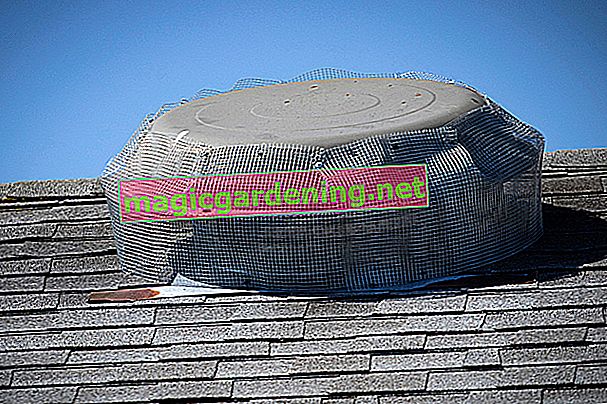
Rats are agile climbers and squeeze through tiny openings and crevices. Slam the door in front of the bold intruders with these precautions on the house:
- Close door gaps : Close gaps with rubber lips or brush strips
- Grill entrances : equip doors, windows, ventilation shafts with small-meshed grilles (less than 18 mm)
- Sealing supply pipes: repair damaged pipes and lines
- Plastering openings : Close openings in the wall with plaster, concrete, rock wool or grids
- Install backflow flaps : Secure the drainage pipes with backflow flaps
- Repair broken roof tiles : Examine roof tiles for damage and repair them after every storm
Rats always want to be close to the water. This property makes the entire inflow and outflow system in the house a potential gateway for pests. Regular care and maintenance of the sewer system and connections of house connections to the public supply network effectively prevent rat infestation. This includes that no leftover food is disposed of in the toilet, which magically attracts the voracious pests.
Prevention of rats in the garden
A little caution is enough to make the garden repellent for brown rats and free-living house rats. The pests are constantly on the lookout for a rich source of food and a safe haven. With these preventive measures you can thwart the rodents in your garden:
- No food residues on the compost : throw organic kitchen waste in the residual waste bin
- Feed pets indoors : feed the dog and cat indoors , empty and rinse bowls promptly
- Close the bio bin tightly : Fit the lid of the bio bin with a rubber seal or use a grub lid
- Store yellow bags in a safe place for rats : Store yellow rubbish bags in locked rooms until the day of collection
Food supplies for chickens, fish or ducks are a richly laid table for rats. It's worth the effort to keep the supplies in the basement or in the rat-proof shed.
Rat control indoors and outdoors
YoutubeAre our recommendations for rat preventive measures coming too late? Rat droppings in the house require immediate action. The rodents are dangerous vectors of disease, cause expensive damage and contaminate your food. Most of the time, the beasts appear in packs, reproduce very quickly, are extremely clever and suspicious. Without consistent and timely countermeasures, you will have a rat plague on your neck within a short time.
The occasional occurrence of rat excrement still opens up an acceptable window of time to drive the clan away with home remedies. The following agents have a chance of success in the early stages of rat infestation:
- Live traps with peanut butter as bait
- Put used cat litter in a cloth bag and hang it near rat droppings latrines
- Soak a cloth in turpentine and place it in suspicious places
- Sprinkle black pepper or chilli powder on walkways
The increased occurrence of rat droppings of various sizes suggests that the pests have started to multiply. There is not much time left for experiments with gentle deterrents. Do not hesitate any longer and contact a tested, certified exterminator who is familiar with the control of rats.
frequently asked Questions
Do you have to report rat droppings in the house?
In Germany there is an obligation to report rat infestation, which is stipulated in a regulatory authority ordinance on rat control. Property owners, homeowners and tenants alike are obliged to do so. According to Section 2, every urgent suspicion must be reported to the competent authority, such as finding rat droppings in the house or garden. The public order office is responsible in most municipalities. The report can be made in writing or orally. Risk investigation measures are then initiated, either by the authorities themselves or by a specialist company.
How long is rat droppings contagious?
Rat droppings are contagious for a few days even when dry. Direct contact with the excrement is not necessary for the transmission of viruses. Frequent cases of infection with the hantavirus happen because the pathogens are inhaled with the dust or enter the organism through minor skin injuries during gardening.
We managed to drive all the rats out of the house. What remains is an unbearable stench of faeces. How can we remove the smell of rat feces?
Conventional cleaning agents are lost in the face of the intense ammonia stench that rats leave behind in the house with feces, urine and smear marks. Microbiological-based products, such as Biodor Pet Animal, have proven to be effective against the smell of rat faeces in practice. The environmentally friendly concentrate is diluted with water and applied over a large area. Ideally, keep the areas slightly damp for two days. Usually one treatment is enough to finally get rid of the unbearable rat faeces odor in the house. The product is available in hardware stores and online shops at a price from 12 euros per liter.
Is rat droppings toxic to dogs?
Rat droppings are just as dangerous for pets as they are for us humans. Young dogs in particular will eat everything that comes under their noses because their natural warning instinct is not yet fully developed. If you suspect that your darling has eaten rat excrement, consult the vet as soon as possible. Ideally, collect the remains of the excrement with disposable gloves and a respirator so that you can take the sample with you in an airtight plastic bag. In the laboratory, the veterinarian can determine whether the rat excrement is contaminated with viruses and initiate the right treatment for your dog in good time.
Despite all of the rat droppings pictures and detailed explanations of how they look and how they compare, are we still not sure? What to do?
Get advice from pest experts. The Lower Saxony State Office for Consumer Protection and Food Safety (Laves) offers a professional faecal examination under the heading zoo diagnostics. For this purpose, send the indefinable solution along with a form stating the circumstances of the find. At a reasonable price of 12.50 euros, the experts determine which animal the excrement can be assigned to.
Tips
The compost heap becomes a paradise for rats if you don't dispose of vegetable and cooked leftovers here. One of the best preventative measures to prevent garden rats cheekily invading the house is with knowledgeable composting. Cuttings of all kinds, coffee grounds, wilted flowers or chopped twigs are only slightly attractive to rats and still turn into nutritious natural fertilizers.

